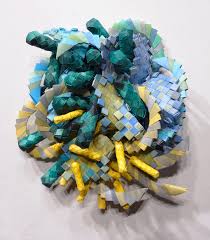Bridging two worlds
- Carol Anne Jones

- Jun 12, 2018
- 2 min read
Updated: Aug 24, 2020
Recently while marking visual art papers, one candidate’s study talked about scientists and artists in contemporary times bridging the two worlds by asking the same sort of questions about factual truth and where it lies. The idea of using data scientific data to make works of art is a thrilling part of the artistic process because you never know how the outcomes are going to turn out. This was true for me when for one of my series I used imagery for data collection based in methodologies rooted in disciplines such as anthropology and sociology.
One artist whose work is exciting and uses scientific data is Nathalie Miebach.
Her work as her artist statement says, focuses on the intersection of art and science and the visual articulation of scientific observations. She uses the methodologies and processes of both disciplines, and translates scientific data related to astronomy, ecology and meteorology into woven sculptures.
Her method of translation is principally that of weaving (principally basket weaving) which provides her with a simple yet highly effective grid through which to interpret data in three-dimensional space. She stays true to the numbers and her woven pieces tread an uneasy divide between functioning both as sculptures in space as well as instruments that could be used in the actual environment from which the data originates. Central to her work is her desire to explore visual aesthetics play in the translation and understanding of science information. Science data has been traditionally visually translated through graphs and diagrams and her works provoke expectations of what kind of visual vocabulary is considered to be in the domain of ‘science’ or ‘art’.
Working with data is interesting and I'd recommend to check out her artworks.























Comments